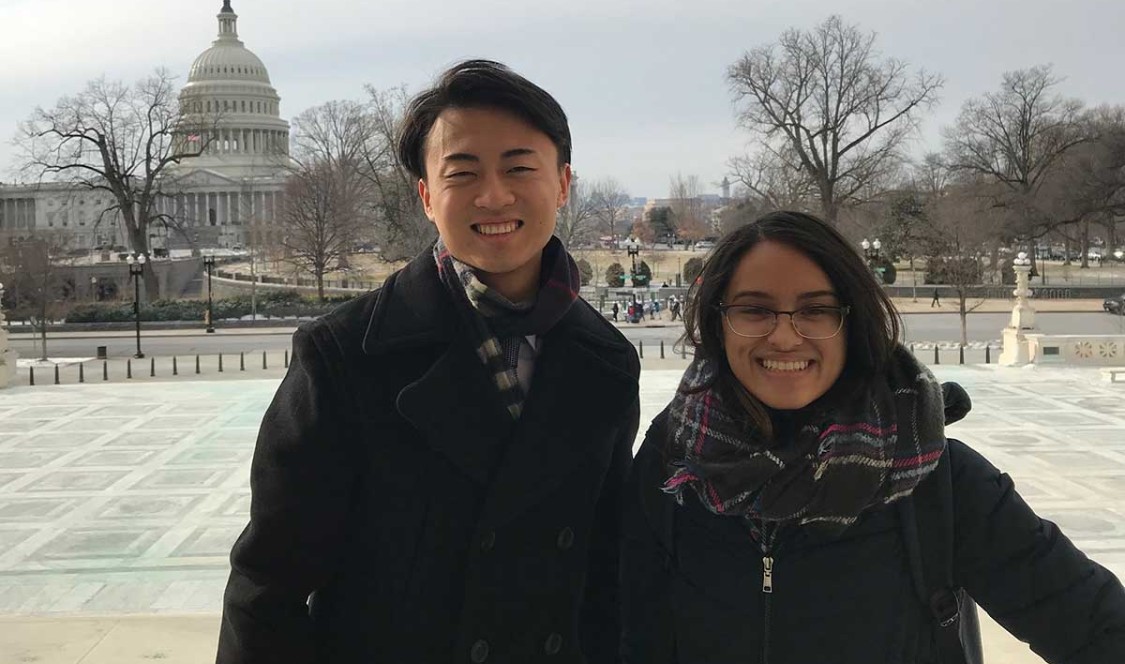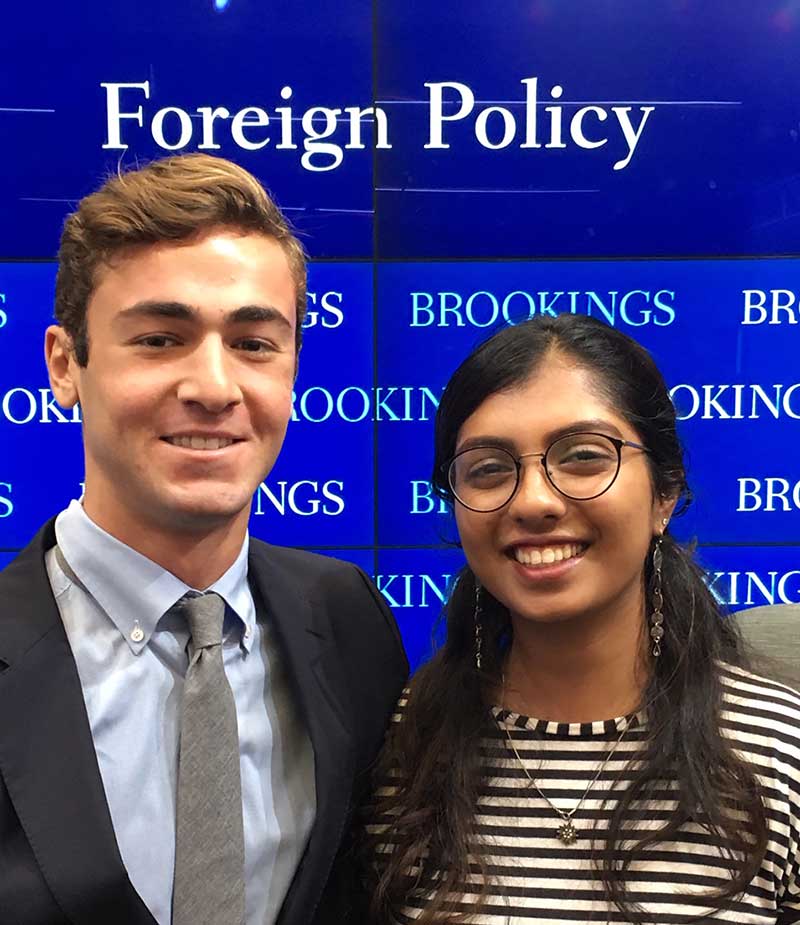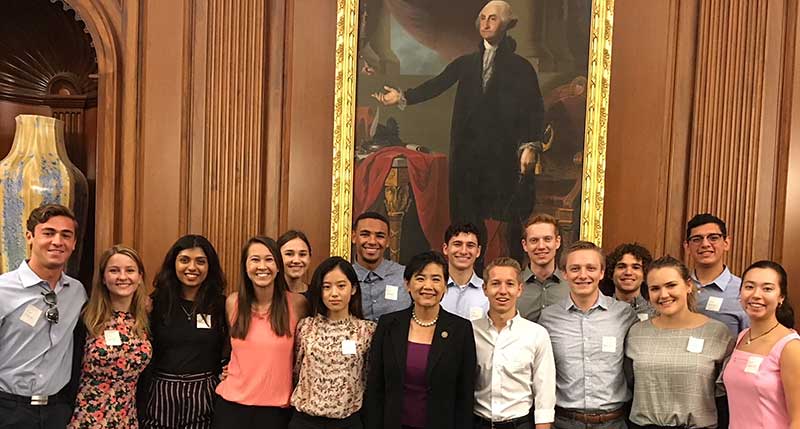In 1973, students arrived in Washington, D.C. to study government at its epicenter while working full time. It was a contentious period for the country. Richard Nixon was in the White House and the news filled with images of Vietnam and long lines at gas pumps. In the evening, the CMC Washington Program’s first cohort gathered in a rented office to discuss the policies and processes they were witnessing firsthand.
Forty-five years later, CMC’s program is firmly entrenched in the nation's capital. The 15 students participating this semester hold internships in places from Capitol Hill to the National Portrait Gallery. They work with dedicated faculty and advisors in both D.C. and at Claremont, and convene in the program's permanent home on 17th Street, blocks from the White House.
As the program celebrates its anniversary with a reception for students, faculty, and alumni on October 11th, it is the future that is foremost on the mind of the program’s new Director and Professor of Government, Maija Harkonen.
Harkonen, a native of Finland who joined CMC in August, was most recently the executive director of the Center for the Study of Democracy at St. Mary’s College of Maryland. Coming to CMC, she said, was an easy decision. There was the college’s academic standing, of course, and an opportunity for her to both direct a program and teach.
“I truly enjoy helping students uncover their strengths and address their weaknesses so they are prepared for the future,” said Harkonen, who received her B.A. at the University of Texas-Austin and her M.A. and Ph.D. in government at Georgetown University. “The position combined a lot of elements that I was familiar with from my past experience, but it was my visit to CMC that sealed the deal. I felt at home right away.”
A distinct advantage
One thing that has remained the same through the decades is the D.C. program’s rigorous and atypical mix of work and study. Few colleges had any kind of internship program in the 1970s. That is no longer the case, but CMC’s program still stands out.
“One thing that has always set our program apart is that our students work full time,” said John Pitney, Roy P. Crocker Professor of Politics. “Most interns work part time, which makes it harder for them to integrate with the office.”
That difference is a big advantage for CMC students. By coming to D.C. in fall or spring, students also are in a position to “choose what they like,” Harkonen said, instead of competing for opportunities with other summer internship programs.
This year’s students—nine from CMC and the remainder from Scripps and Pomona colleges—are working in a range of industries including media, international law, consulting, government agencies including the SEC, and the office of Rep. Nancy Pelosi.
“The program works for young people with very different backgrounds,” Harkonen said. “We can help them find internships in fields from IT to art. There is so much more in DC than the government. It is a hub for everything.”
Students take three courses: Policy Analysis, The President and Foreign Policy, and an independent research project. Harkonen said while the program is rigorous, students are energized as they balance their jobs and their studies. The cohort is also encouraged to explore cultural, educational, and political events around the city. One recent group venture out was a lecture on the future of the European Union by the President of Finland at The Brookings Institution, Harkonen said.
Pitney sees the change in students returning to campus after a program he calls, “a great education in time management.”
“They come back much more mature, much better able to manage their lives, and go on to great things,” he said.
Expanding its impact
With the help of Skype meetings and email, students this year are taking advantage of a new program dimension by working with faculty in Claremont on their research throughout the semester. In previous years, they had only worked independently. Technology has made the process of finding and applying for internships easier—gone are the days, Pitney said, when he leafed through a big book of listings and contacts he balanced on his knee. Tweaking the program’s courses to keep up with changes in the world is an ongoing process, as well.
“What I was teaching as current events is now history,” said Pitney, who taught with the D.C. program from 1989-1991.
Harkonen expects courses to evolve in the next few years to reflect the issues policymakers, business, and society are now grappling with such as cybersecurity, Internet of things, weapons systems, and increasing automation.
“Some of the areas are new to all of us and do not yet have laws on the books,” she said. “Around the world, China and India have become more prominent and there are tensions in spots that were not on our radar even ten years ago,” she said.
To that end, the importance of a liberal arts education to prepare students for work in government and industry cannot be overstated. Harkonen said one of her primary goals is encouraging both students and faculty in Claremont to consider spending time in the program.
“I would like to see even more interaction between D.C. and the campus. For faculty, spending a few weeks here could be an opportunity to do research and to lecture,” she said.
A less obvious benefit of the program runs the opposite direction, Pitney noted. Students who have participated in D.C. enrich discussion on campus when they return.
“Nearly every upper level class I teach has a veteran of the program in it,” he says. “I rely on them in class for insights. The program benefits participants but also the campus community overall.”
—Susan Price



